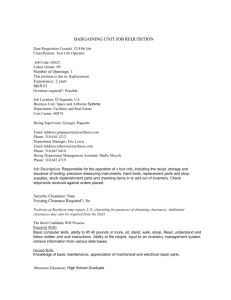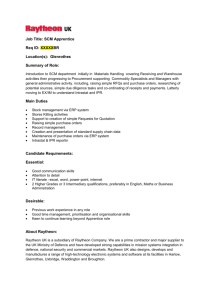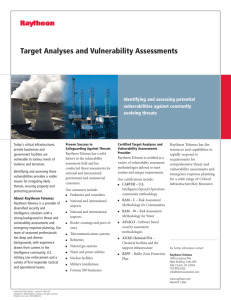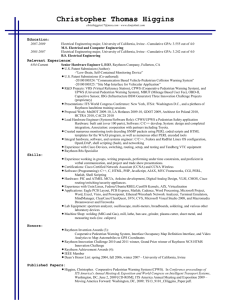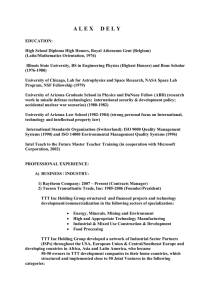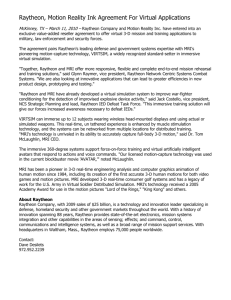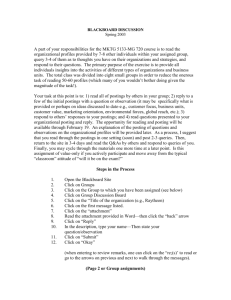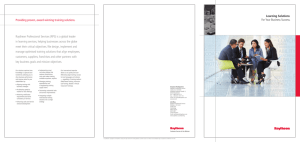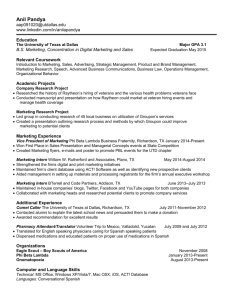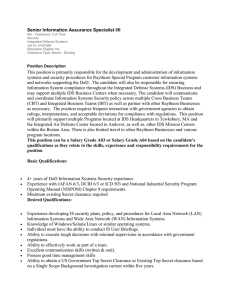Case Study Report: The Paveway Program Transformation TM
advertisement
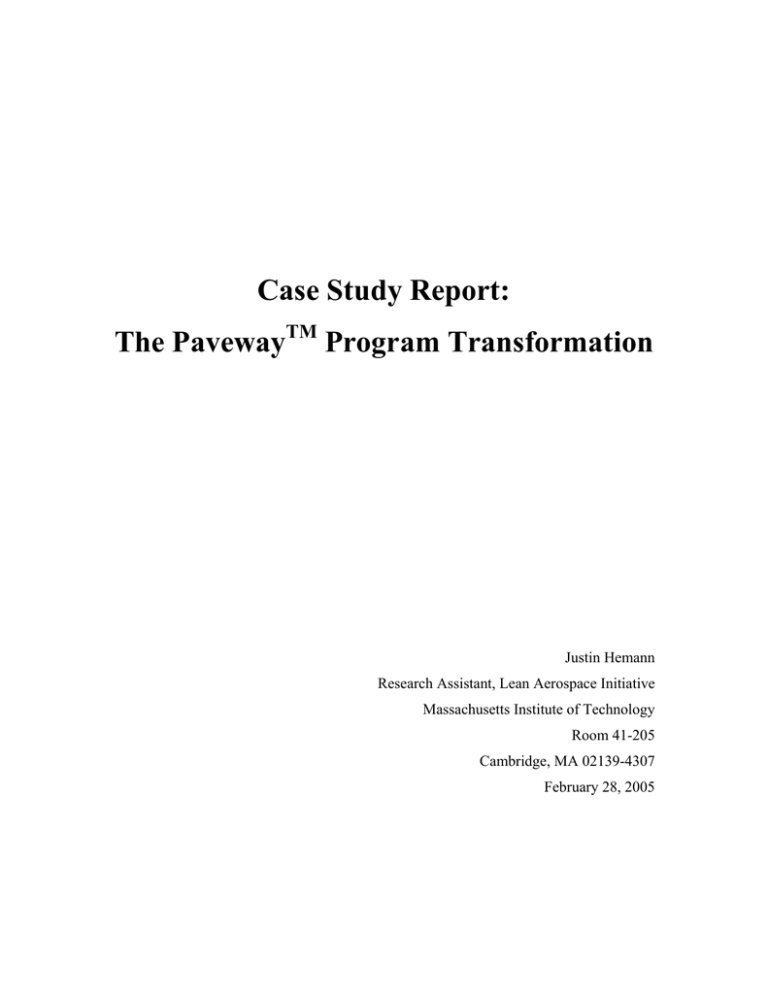
Case Study Report: The PavewayTM Program Transformation Justin Hemann Research Assistant, Lean Aerospace Initiative Massachusetts Institute of Technology Room 41-205 Cambridge, MA 02139-4307 February 28, 2005 http://lean.mit.edu Massachusetts Institute of Technology Cambridge, MA 02139 Lean Enterprise Change Research Case Study Series This case study provides an example of managerial and organizational changes that have accumulated into significant performance improvements. It is one of a series of case studies undertaken by researchers at the Lean Aerospace Initiative (LAI) at the Massachusetts Institute of Technology. LAI focuses on developing, testing and studying the application of lean and other management principles in the aerospace industry. LAI’s sponsors, and their improvement initiatives, have created a natural laboratory for studying lean enterprise efforts. The case studies in this series report on interesting and novel applications of lean methodologies at enterprise levels in LAI-sponsoring and other companies. This material is based on research sponsored by the Air Force Research Laboratory (under agreement number FA8650-05-2-5706) and a consortium of other government and aerospace industry members. The U.S. Government is authorized to reproduce and distribute reprints for Governmental purposes notwithstanding any copyright notation thereon. The views and conclusions contained herein are those of the author and should not be interpreted as necessarily representing the official policies or endorsements, either expressed or implied, of Air Force Research Laboratory, the U.S. Government or other consortium members. © Massachusetts Institute of Technology, 2006 CONTENTS 1. INTRODUCTION 2 2. BACKGROUND 3 2.1. A brief history of bombing 3 2.2. Enter PavewayTM 3 3. THE PAVEWAYTM PROGRAM TRANSFORMATION 5 3.1. After the Baldrige Award: 1992 – 1999 5 3.2. Rebuilding in Tucson: 1999 – September 10, 2001 7 3.3. Rising to the challenge: September 2001 – November 2003 11 3.4. Enter Lockheed Martin: November 2003 – present 13 4. KEYS TO SUCCESS 16 4.1. Forcing function 16 4.2. Focused leadership 16 4.3. Cumulative improvement 17 4.4. Adaptive culture 18 4.5. Guiding principles 19 5. CONCLUSIONS 19 Case background and methods 21 References 21 1 1. Introduction On a Monday in June of 1999 the PavewayTM production line restarted in a hastily erected tent at Raytheon’s Tucson, Arizona facility. It did not look or perform like the PavewayTM program that had won Texas Instruments the prestigious Malcolm Baldrige National Quality Award just seven years earlier. The move had been quick – four days – and executed on a shoestring budget. Photographs and sketches were used to piece the production line together like a giant jigsaw puzzle. Only 25% of the Texas Instruments personnel made the move to Arizona, so PavewayTM was in the hands of a new team and a new culture. Over the next four years the program would see weak morale and performance, a huge surge in demand following 9/11, and intense pressure from a competitor. Challenges like these have ended programs and entire companies. Or they have necessitated Herculean efforts to keep production stuttering along year after year. Yet PavewayTM met these challenges and emerged as a best-in-class program and winner of the 2004 Shingo Prize. Today PavewayTM costs are a fraction of 1999 levels, customers are satisfied, and the PavewayTM team at Raytheon is motivated and successful. Along the way the program has developed abilities at all levels. For example, a team of three production workers had an idea to make their packaging process faster and less tiring. They talked it over with supervisors, retrieved some parts from the salvage yard, and rebuilt their workstation. In two days. They had pride in their work, and managers noticed the change. One recalled, “When that started to happen I knew we had arrived.” How did this transformation take place? What kind of capabilities does an organization need to survive and flourish under such challenges? This case seeks to tell the story of the PavewayTM program from 1999 to the present. Specifically, the purpose is to create better understanding and guidance for managers, facilitators and participants at all organizational levels for the types of changes and change processes that enable enterprise transformation. 2 2. Background 2.1. A brief history of bombing Bombs have been dropped from aircraft onto ground targets since the first World War. For decades the basic principles were unchanged: an unguided bomb will fall to the ground in a way that is entirely determined by the conditions at release (speed and direction and so forth) and any influences on the way down, such as wind. Accuracy is improved by dropping bombs from low altitudes, but low-flying aircraft are vulnerable to ground fire and other aircraft. In the Vietnam conflict airplanes were flying higher, faster, and farther than ever, but their effectiveness against ground targets was still limited. For example, US forces flew over 800 sorties to destroy the critical Than Hoa bridge in North Vietnam (a sortie is one attack by one aircraft). Ten aircraft were lost to ground fire, and the unguided bombs never hit the bridge, though the surrounding area was heavily cratered by near misses. Finally in 1972 four aircraft carrying PavewayTM I laser-guided bombs destroyed the bridge. Precision bombing would change warfare forever. 2.2. Enter Paveway TM The PavewayTM program started in 1968 to meet the needs of US forces in Vietnam. PavewayTM is a two-piece system that attaches to the front and back end of existing unguided bombs (see Figure 1). The front piece is called the seeker. As the name suggests, the seeker steers the falling bomb toward the target with moveable fins. The tailpiece is added for stability and balance. It is inactive – the seeker does all of the steering. Raytheon builds the seeker at its Tucson facility, but the more simple tailpiece is built in Sherman, Texas. 3 Tailpiece Bomb Seeker Figure 1: A PavewayTM bomb. Guidance is the key to PavewayTM’s unprecedented accuracy. The bomb automatically steers itself towards reflected laser light. The laser source can be a hand-held unit used by special forces soldiers on the ground, a laser designator on another aircraft, or the laser may come from the same aircraft that dropped the bomb. Regardless of the laser’s source, the PavewayTM seeker will steer itself toward whatever the laser is pointed at. In this way a moving target, like a truck, can be targeted by following the target with the laser designator. All of the PavewayTM variants use laser guidance (see Figure 2). PavewayTM III systems have upgraded seekers that are capable of high off-boresite operations. This allows the bomb to be pointed away from the target, enabling longerrange attacks that can keep aircraft outside the range of air defenses. Furthermore, the bomb’s trajectory can be tailored for maximum effectiveness against difficult targets such as bunkers. Smoke or clouds can block a laser and make laser guidance impossible. Some PavewayTM variants add another guidance method that uses signals from the Global Positioning System (GPS) satellites (see Figure 2). Smoke or clouds do not affect GPS guidance. Furthermore, there is no need to keep a laser pointed at the target. However, GPS guidance cannot be used to follow moving targets, and the target’s GPS coordinates must be programmed into the bomb. For fixed targets, like a building or airstrip, this is a trivial task, but for movable targets, like a mobile missile launcher, determining the coordinates is more difficult. 4 Laser Guidance X X X X PavewayTM II PavewayTM IIE PavewayTM III PavewayTM IIIE GPS Guidance High offboresite ability X X X X Approx. unit cost $10,000 $35,000 $65,000 $100,000 Figure 2: Major PavewayTM variants. Today the US military has a wide variety of precision weapons, which are an integral part of US strategy and tactics. Half of the precision weapons dropped in the 2003 Operation Iraqi Freedom were PavewayTM bombs. PavewayTM’s usefulness is aided by the fact that PavewayTM II is the least expensive precision weapon in the US inventory. 3. The Paveway program transformation TM The PavewayTM program started in 1968, but this case focuses on the transformation of PavewayTM after Raytheon acquired the program and moved it from Texas to Tucson, Arizona in 1999. However, any story about change must describe a starting point, along with the finish, so that the change can be fully understood. Therefore, this case includes background information from the program’s birthplace at Texas Instruments. A timeline is included on page 15. 3.1. After the Baldrige Award: 1992 – 1999 In 1992 the prestigious Malcolm Baldrige National Quality Award was awarded to Texas Instruments Defense Systems and Electronics Group, makers of PavewayTM. A defense contractor had never won the award before. Indeed, one could argue that Texas Instruments (TI) was really a commercial electronics company that happened to make a few products with defense applications. For years the TI defense business was small enough, relative to the rest of the company, that it did not warrant a separate division. The PavewayTM program and its $300 million yearly sales was part of the “Equipment” group. In 1990 TI was using a number of process improvement initiatives, including Motorola 6σ and IBM’s Continuous Flow Manufacturing (CFM). The company culture 5 emphasized a “work smarter” over “work harder” mentality that helped the process initiatives take root, but the company culture didn’t change significantly until management decided to enter TI’s defense division in the Baldrige Award competition. The PavewayTM production line would be the centerpiece of the application process, which is described by the Baldrige National Quality Program: To apply for the award, organizations must submit details showing their achievements and improvements in seven key areas: leadership, strategic planning, customer and market focus, information and analysis, human resource focus, process management, and results. Applicants receive 300 to 1,000 hours of review and a detailed report on the organization’s strengths and opportunities for improvement by an independent board of examiners. “The application and review process for the award is the best, most cost-effective, and comprehensive business health audit you can get,” said Arnold Weimerskirch, former Baldrige Award judge and vice president of quality, Honeywell, Inc. TI applied but failed to win in 1990 and 1991. One former TI engineer related how he initially felt that Baldrige activities were “jingoistic and taking away from real work.” But over time the PavewayTM program evolved a more customer-focused culture, one that changed the definition of customer for many. According to a former TI employee, “The Baldrige criteria changed the culture to serve external and internal customers.” Furthermore, this customer focus was tied directly to operations: “We saw that the award looked for customer links, so we ensured that the right process existed and worked.” The non-union production workers were not constrained by restrictions on cross training, and teaming was emphasized and encouraged (Rosson 1994). On TI’s third attempt in 1992 they won the Baldrige Award. But the changing global and business environment would make celebrations short-lived. Orders for the main product, the PavewayTM II, dropped after the end of operation Desert Storm. In 1993 The US government stopped ordering PavewayTM II, and would not resume orders for another 6 eight years. PavewayTM III/IIIE production continued, as did PavewayTM II production for foreign clients, but the number of units sold were significantly reduced. Downturns in the defense industry are marked by mergers and acquisitions, and 19931997 were very active years. Raytheon emerged from this period as a major consolidator; Hughes Aircraft Company purchased General Dynamics’ missile business in 1993. The California General Dynamics site was closed, and a poor California economy combined with a generous relocation package prompted about 70% of the General Dynamics employees to make the move to new jobs in Tucson. At the time General Dynamics was doing well in the marketplace so there was an incentive for Hughes to keep their managers and their customer relationships. In 1997 Raytheon acquired Hughes’ missile business in Tucson, Arizona and Later that year Raytheon added another company to its portfolio by acquiring TI’s defense division, including the PavewayTM program. PavewayTM was manufactured in Sherman, Texas, which is about 40 miles north of Dallas. After Raytheon’s purchase the Sherman facility was split between the PavewayTM production line and other TI businesses. This awkward situation did not last long, however. Production moved to Lewisville, Texas, which is about 25 miles north of Dallas (metal fabrication stayed in Sherman, however). The move was not well received by many of the employees. Jobs were plentiful in the area thanks to the recent telecommunications boom, so many employees chose to stay in Sherman. When production resumed in Lewisville the cycle times and costs increased by a factor of three. But PavewayTM did not remain in Lewisville for long. In 1999 Raytheon moved the line again, this time to Raytheon’s Tucson, Arizona, site to be alongside the other former Hughes and General Dynamics programs. This move was compensated more highly than the last, yet only 25% of the former TI employees left Texas for Arizona. 3.2. Rebuilding in Tucson: 1999 – September 10, 2001 In June of 1999 PavewayTM began operating in a tent at Raytheon’s immense Tucson facility – the intended home of the line was still under construction. Another move followed in September, this time to a large hallway that linked some of the 26 factories at 7 the site. PavewayTM did not reach its current home until a third move in December. The new facility was a dramatic improvement. A “grid” of utility connections suspended from the ceiling allowed machines to be quickly rearranged and connected with the requisite electrical, water, and air lines. Free space was hard to find, however. Large parts inventories left little room for offices or meeting places, so engineers and work teams were often far from the production line. Rearranging machines or optimizing production would have to wait. The focus for the first six months was to reconstruct the line as it had existed in Lewisville. Drawings and photographs were used to piece the line together “like a giant jigsaw puzzle”. Only 25% of the personnel made the move to Tucson (and none of the operators), so new operators and engineers had to be trained. Gaps in how processes were documented and how they were really performed became apparent. Overall, the move was described as “a huge drain on resources”. By 2000 PavewayTM III/IIIE production was “in the red”, over cost and behind schedule. As the production line was rebuilt, so was a new Raytheon culture. Former employees of Hughes, General Dynamics, and Texas Instruments worked together with Raytheon employees in a 1999 meeting to define a new Raytheon process improvement program. One attendee described the meeting as “contentious because everyone had pride in ownership.” The state of process improvement programs prior to the meeting is summarized in Figure 3. 8 Program Heritage Agile Hughes Continuous Flow Manufacturing Texas Instruments Six Sigma Texas Instruments - Raytheon, General Dynamics Comments • Similar to Toyota’s Lean Production System, but renamed “Agile” to avoid Lean = mean connotation. • Developed from Hughes parent company – General Motor and its New United Motors Manufacturing (NUMMI) Toyota transplant experience. • Features process and value stream mapping. • Tended to be formal and structured with emphasis on documentation. • Agile training emphasized teaching. • Team based problem solving is emphasized. • TI’s implementation had a strong customer focus. • Relatively informal and unstructured with less documentation. • Tended to view consultants as “hired guns” rather than teachers. • Well developed quality program from heritage in semiconductors; included quality experts that were deployed to help production • Partners with Motorola, IBM and others in developing and applying quality methodology • Relatively undeveloped process programs. Described as “primitive”. Figure 3: The state of process programs at Raytheon’s Tucson facility in 1999. At Raytheon’s corporate headquarters in Massachusetts the new President Dan Burnham was leading the development of Raytheon Six Sigma™. Other initiatives were discarded or assimilated. In 2000 Hughes’ Agile was renamed Raytheon’s Principles of Manufacturing, or RPM, and placed under the Raytheon Six Sigma™. “This put a Raytheon face on our methods”, said a manager. This was one measure among many to create a new culture. For example, Burnham chose a new corporation-wide name for their improvement program that was not used by any of the acquired companies. 9 According to another manager, “Burnham went out of his way to break down barriers between the cultures.” By the middle of 2000 Raytheon was progressively integrating its programs in Tucson. Pat McKinney, formerly of Hughes, stepped in as the new PavewayTM Production Manager. He led an Agile program to “get everyone rowing in the same direction.” Each production line followed a 12-week timeline, and each would be rated on the same Operations Performance Metrics (an adaptation of Oregon Productivity Matrix research from Oregon State University). The result was that all programs shared “a common language, focus, and direction.” Several Raytheon Six Sigma™ projects started with the overall goal of getting the program’s cost and schedule under control. These improvement projects set off the cultural transformation on the PavewayTM production lines. Suggestions were heard and acted on. Some of the union production workers resisted the changes initially, with the mindset that Raytheon, “wanted to get more work with the same pay.” Increasing production rates caused some workers to rename the program “Slaveway”. Supervisors knew that they needed to win over the production workers, and they knew how to do it. According to one supervisor, “Buy-in comes from building trust with the operators.” Safety and the elimination of repetitive strain injuries were emphasized. Over time production workers found that improved tools and processes allowed them to do more work with less effort. For example, in January of 2001 the PavewayTM II/IIE production workers played a major role in the redesign of their manufacturing areas – the first and second shift competed to submit the best new layout. Operators proposed ideas, talked it over with the supervisors, and implemented the changes that weekend. According to one production worker, “Management is always looking for ways to make things easier. They listen.” Another adds, “If we need something, we ask [the supervisors], and we get it 90% of the time.” By August of 2001 the factory floor had changed completely, and a “success breeds success” dynamic was taking over. Project leads were preparing presentations for a Raytheon-wide 6σ competition in September where they would get a chance to compare 10 their successes with other 6σ projects from all over the company. These projects had little support beyond Pat McKinney, but this would change when Donna Ellington joined PavewayTM as the Program Manager on September 4th. Donna had experience with highvolume production with Raytheon’s TOW missile program, though demand was low in her new program. PavewayTM IIE production was about 200 per month, and PavewayTM II orders from the US government were trickling in again after an 8-year hiatus. Donna’s initial focus was to get the program’s financial situation under control. Inventories for some parts could last eight months, while other stocks were almost empty. And few people really believed the MRP system or the book value of the inventories. Donna brought in Dave Cain, also from TOW, as the new Manager of Production Programs. Dave compared the program-level situation in 2001 to “an alcoholic family,” completely broken and dysfunctional. One week after Donna joined PavewayTM the world changed. A military response to the 9/11 attacks on the World Trade Center and Pentagon seemed inevitable. Air travel and the Raytheon Six Sigma™ competition were cancelled, and in the following days several US generals called Donna and asked, “How many of these [PavewayTM] can you make, and when can I get them?” 3.3. Rising to the challenge: September 2001 – November 2003 “After 9/11 we took a strategic view. We must change.” The PavewayTM Production Control Manager summarized what everyone in the program knew: US stockpiles of precision weapons were low, and another conflict would come soon. Production rates had to rise dramatically. Generals were calling Donna Ellington daily and asking about different production scenarios, in one case a rate of 9,600 PavewayTM II per month. But PavewayTM II had never been built at that rate, and PavewayTM IIE rates were around 200 per month. The program must change. Donna Ellington summarized the situation for the generals. Production rates are constrained by the lowest of three factors: 1. Implemented capacity – what is the capability of your factory, your line and the material and the assembly that you could push through? 11 2. Staff capacity – do you have the people to operate the workstations? Are they trained to operate at the speeds that are necessary? 3. Material flow – do you have a steady flow of material to build the product as you would like? On 9/11 the implemented capacity for PavewayTM II was about 650 per month. The Tucson facility has 26 production lines in all, so staff constraints could be satisfied by borrowing people from other programs, or overtime. The bottleneck in the months following 9/11 was material availability. “The hardest months,” said Donna, “were December and January 2002.” Over time the parts deliveries caught up, but then a new bottleneck would form elsewhere. The energized PavewayTM team examined every part of the manufacturing process and set about making their operations faster and more reliable through a series of Raytheon Six Sigma™ projects. Some examples of the changes are provided below. • A “supermarket” inventory system was implemented next to the factory floor to keep parts close to the line, easily accessible, and visible to everyone. • The Production line was completely re-arranged and product travel distance was reduced from 2.5 to 0.4 miles. • Just-in-time deliveries were arranged with suppliers and a trucking company. Trailers containing one week of parts are left at the loading dock, and parts are withdrawn as needed. At the end of the week the empty trailer is replaced. • Rollers were installed so that parts could easily slide between work stations. • Production workers were cross-trained, often in three roles, so that labor resources could quickly move to where it was needed most. • Parts containers were sized so that workers would not run out near the end of the day when there may be reluctance to open a new container. • Parts are packed so that operators can take a box to the floor, open it, and pull parts quickly at their workstation. Kitting was reduced dramatically. “We used to spend thousands of dollars kitting seven cent screws,” according to a supervisor. Packaging is sent back to suppliers and re-used. 12 • Testing requirements were re-examined by engineering, and the testing process was shortened. By June of 2002 the PavewayTM II production rate had climbed to 1000 per month, but going higher was becoming progressively more difficult. Some of the new bottlenecks were not on the factory floor. Higher levels of leadership were necessary to overcome the obstacles that crossed organizations. For example, testing was a major bottleneck until the requirements were changed. According to Pat McKinney, “Donna Ellington was instrumental in aligning engineering to relax test requirements.” In November of 2003 the PavewayTM II production rate was passing 1500 per month, and the PavewayTM team continued to improve their production system. Furthermore, they were anticipating two supplemental contracts from the US Air Force and Navy totaling $108 million. But when the contract announcement came Raytheon was “devastated.” Lockheed Martin won both contracts with their PavewayTM II equivalent by under-bidding Raytheon. 3.4. Enter Lockheed Martin: November 2003 – present Lockheed Martin developed a Laser Guided Training Round in 1992. It was cheaper than a laser guided bomb, but for training purposes it functioned just like the real thing, which allowed militaries to reduce training costs. In the following years Lockheed Martin tried to expand its business by winning government support and funds to develop its own version of PavewayTM II. The government was not receptive to the requests. Finally in 1999 Lockheed Martin invested $15 million to develop and certify a PavewayTM II equivalent that met the same specifications. Orders began to trickle in; the first was from the Australian Air Force for $2.7 million in December 2002. The first major order for Lockheed Martin did not come until the $106.6 million contract with the US Air Force in March of 2003. This was the smaller piece of a two-part order. Raytheon took the larger share, $173.7 million. Along with the contracts, the Air Force also announced that they anticipated $2 billion in PavewayTM orders through 2009. 13 Before 2003 there was there was no direct competition for PavewayTM II. Other weapons, such as JDAM, had overlapping capabilities, but Lockheed Martin’s entry changed everything. In this new competitive landscape the major PavewayTM customers, the US Air Force and Navy, implemented seven year IDIQ (indefinite demand and indefinite quantity) contracts with Lockheed Martin and Raytheon. Either company can win orders, and there is a defined split so that each gets a minimum of 30% per year. The IDIQ contracts are designed to make the bidding process less contentious. A Navy customer described the Raytheon and Lockheed Martin competitions as “a nightmare” that were full of protests. IDIQ decisions, by law, cannot be protested. If the winner cannot produce fast enough then supplemental contracts are used, which can be sole-source. In March the 2003 Raytheon had captured most of the IDIQ contract; 62% and $173.3 million to Lockheed Martin’s 38% and $106.6 million. But in November Lockheed Martin captured two supplemental contracts totaling $108 million. The sudden change of fortune was easy to explain: in the intervening months Lockheed Martin had worked hard to lower costs and bid below Raytheon. To be competitive the PavewayTM team had to lower costs before the next year’s IDIQ contract would be announced. An intensive cost cutting initiative followed. Over 130 individual reduction items were identified, and costs were cut 15-20% for the next round. Hardware, circuit boards, and processes were adjusted. No change was too small – one improvement saved four cents per unit. In January 2004 manufacturing engineers were moved down to the factory floor to foster relationships that would lead to better manufacturability. Low inventory levels – only two weeks – freed up enough space to make room for them. The next contract announcement came in March 2004. This time Raytheon won 70% of the IDIQ contract. The PavewayTM team’s quick response resulted in Raytheon taking the maximum amount. Would Raytheon be able to sustain the lead? Ben Ford, the new Program Director, summarizes the team’s attitude well: “Wins tend to oscillate. My job is to break the cycle.” 14 Paveway II program Production moves from Lewisville TX to tent in Tucson AZ Production moves Layout change in from tent to hallway factory to final location ŅSupermarketÓinventory system introduced Raytheon Missile Systems wins Shingo Prize Costs reduced 15-20% Period of greatest cultural change in factory Engineers put on factory floor People Pat McKinney becomes Production Manager Gary Cotten becomes Operations Manager Donna Ellington becomes Program Manager Dave Cain becomes Manager of Production Programs Paveway II production rate (units/month) 0 89, 300, 500 1000 1200 1600 Dollars Paveway II,IIE,III,IIIE quarterly production value 1999 2000 2001 2002 2003 2004 Raytheon wins 70% of IDIQ contract Lockheed wins $108M supplemental contracts Lockheed Martin spends $15 million to self certify production of Paveway II equivalent Lockheed wins $2.7 million contract with Australian Air Force Paveway II competition Figure 4: PavewayTM timeline. 15 Raytheon wins 62% or $173.7M of IDIQ contract 4. Keys to success In March of 2004 Raytheon Missile Systems, including the PavewayTM program, won the Shingo Prize for excellence in manufacturing. Less than five years before the program’s people (those who remained after two moves) were demoralized and housed in a tent. A production worker compared the program to the Flintstones. How did it rise to become a best-in-class manufacturer? How has the organization developed the ability to quickly respond to challenges? What can be learned from PavewayTM’s story? Five qualities are identified in the following sections. An organization with a few of these qualities can expect improvement, but breakthrough performance may require them all. 4.1. Forcing function The PavewayTM program changed because it had to. Three traumatic events provided the impetus: the move in 1999 and subsequent decline, the attacks on September 11, and the entrance of a competitor. Of these challenges 9/11 was the most cathartic for the program. Donna Ellington described it as a “forcing function”. Many workers were motivated by patriotism and the belief that their efforts were helping the US and its allies. The walls of the Tucson facility are decorated with flags and photos signed by pilots who have used PavewayTM in combat. One story exemplifies the bond between pilots and the PavewayTM program. In December 2003 production workers were asked (not told) to work over the Christmas holiday to fill an order for the United Kingdom’s Royal Air Force. RAF pilots visit Tucson every year for training, and their humorous presentations to the PavewayTM team made them very popular. A production operator had just one question for Donna about the holiday work: “Is that for Andy in the RAF?” The operators voted to work over the holiday. 4.2. Focused leadership “After 9/11 the organization was starved for leadership,” recalled a manager. Donna Ellington stepped into this void. “Donna came in as a leader, set objectives, and got alignment. Some people embraced that; others left.” Many people credited Donna and her team for aligning engineering, finance, quality, and the program office. She also replaced several managers. Her leadership was complemented by Pat McKinney’s 16 performance at the operational level. By September 2001 the production workers attitudes had changed from low expectations to competing with other shifts to see who could redesign the factory layout most effectively. Leaders at all levels provided support and respect, and workers responded with trust, responsibility, and a feeling of pride and ownership in the factory. 4.3. Cumulative improvement The story of PavewayTM’s transformation is one of cumulative improvements. When asked about the specifics of how the production rate climbed so quickly, most people mention the factory layout change and supermarket inventory system. But they quickly add more changes: reduced kitting, a robust MRP system, rollers between the workstations, etc. The organization is committed to continual analysis and tinkering with processes and tools. No improvement is too insignificant to implement, not even the process yielding four cents in savings per unit. The accumulated benefits of these changes are evident in high-level metrics such as the program’s working capital, which is the difference between assets (like cash and inventory) and liabilities (such as wages and raw materials). Figure 5 shows that cash has been increasing while working capital has been falling, a situation that is possible only when inventory turnover increases to better utilize existing resources. 17 Figure 5: Increase in cash and decrease in working capital over time. 4.4. Adaptive culture A common theme emerged from interviews at all levels of Raytheon: PavewayTM’s culture was not like other programs in Tucson or the culture at the Raytheon headquarters in Massachusetts. One project leader described the night-and-day difference between PavewayTM and a program down the hall that was much more difficult to operate in. Another project leader described the difference this way: “PavewayTM allows creativity and freedom all the way down to the operator level.” In this culture, team members “leave their egos at the door” and focus on results above all else. Production workers trust that their concerns will be heard and that their efforts will be rewarded. After one improvement drive a portion of the cost savings was funneled into more comfortable chairs for the workstations. There has been only one small layoff in the last five years (in 2001 about 200 people were laid off at a site with 12,000), so workers trust that they will not lose their jobs after efficiency rises. The commitment to cumulative improvement is evident in Figure 6, which shows a steady decrease in touch labor requirements. The shape of the curve is consistent with well-implemented improvement programs characterized by Schneiderman (1998), who wrote, “any defect level, subjected to legitimate QIP [quality improvement processes], decreases at a constant [fractional] rate.” The result is an exponential decline in defects characterized by the ‘improvement halflife’ – the time required for defects to fall by 50 percent (Keating 1999). From Figure 6 we see that the half-life for labor process improvement is about one year. 18 Figure 6: Improvement in PavewayTM touch labor performance. 4.5. Guiding principles Upon entering Raytheon’s Tucson production facility one of the first sights you will see is a wall that is covered, from the floor to the twenty foot ceiling, with pictures of Raytheon’s 6σ certified project leaders, and the Raytheon Six Sigma™ principles spelled out in huge letters. Raytheon seems to have embraced 6σ at all levels, but some managers are less sanguine about the 6σ process. According to one manager, “most 6σ projects don’t amount to anything.” Another adds that once you have gone through the process and learned, then “screw the documentation.” These managers have seen other initiatives – like quality circles, TQM, and concurrent engineering – and they refuse to waste resources on activities that do not produce results. They are sophisticated and experienced consumers of process improvement initiatives, and they use every tool at their disposal (Lean, Agile, 6σ, etc.) to eliminate waste and create value. When the Raytheon Six Sigma™ process impedes these goals then they will discard it too. 5. Conclusions Raytheon turned a struggling program into a best-in-class performer in the space of a few years. A team of dedicated people from all levels – the factory floor to the program director – drove this effort with a common language and set of process improvement tools. Those who seek to understand or replicate PavewayTM‘s success may focus on the 19 role of Raytheon’s 6σ program. Indeed, they may wonder if PavewayTM has succeeded because of 6σ or in spite of it. Addressing such a question with this case is difficult. Much of the information presented here came from two days of interviews, at Raytheon’s invitation, in Tucson during March of 2004. All interviewees were pre-selected by Raytheon, and their comments about the 6σ program were mostly positive or neutral. Under these circumstances, we cannot know if the persons interviewed provide a comprehensive view about PavewayTM and Raytheon Six Sigma™. This caveat notwithstanding, interviews with Raytheon employees from other sites suggest that adherence to Raytheon Six Sigma™ is higher in Tucson than in the corporation as a whole. Most improvement programs fail (Easton and Jarrell, 1998). Sustaining improvement over the long term is an elusive goal, even for the most successful programs. Continued success for PavewayTM may depend on whether the team manages improvement as a dynamic process (Keating 1999). They will have to contend with declining rates of improvement (as in Figure 6) while simultaneously managing the high expectations of leaders and customers. Revisiting PavewayTM in the future may shed further light on challenges inherent to sustaining progress. 20 Case background and methods This case study was developed by researchers from the Lean Aerospace Initiative (LAI) at the Massachusetts Institute of Technology. LAI is a consortium of defense industry suppliers (including Raytheon), consumers, and stakeholders. Researchers at MIT are seeking insights into change processes, insights that may come from examples of successful transformation such as Raytheon’s PavewayTM program. At Raytheon’s invitation two MIT researchers visited the Tucson, Arizona Raytheon facility and conducted interviews with 20 individuals. In addition, we interviewed several Raytheon employees from other sites, and PavewayTM customers. Interview data was augmented with public-domain information about Raytheon and PavewayTM. References Easton, G., and Jarrell, S. (1998) “The effects of total quality management on corporate performance: An empirical investigation,” Journal of Business, 71(2), 253-307. Felix, G., and J. Riggs, (1983) “Productivity Measurement by Objectives.” National Productivity Review, Autumn, pp. 386-93) Keating, Elizabeth K. et. al (1999) “Overcoming the Improvement Paradox,” European Management Journal, Vol. 17, No. 2, pp. 120-134. Rosson, Richard D. (1994) “Self-Directed Work Teams at Texas Instruments Defense Systems and Electronics Group,” MIT Masters of Science thesis, June. Schneiderman, A. (1988) “Setting quality goals,” Quality Progress, April, 55-57. 21
